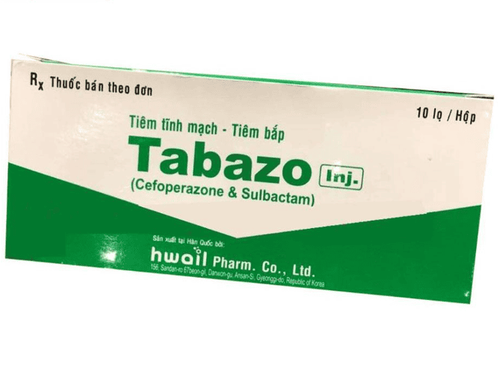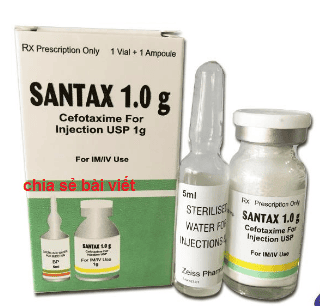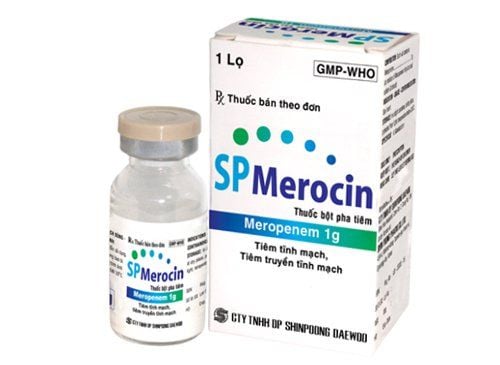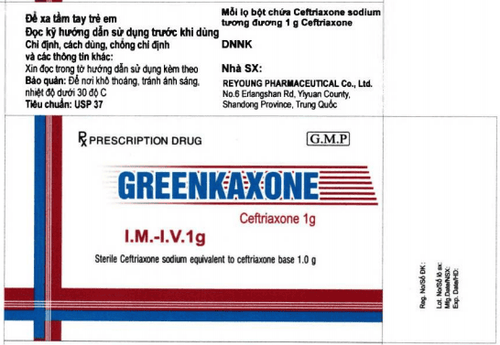This is an automatically translated article.
Romapen is formulated with the main ingredient Meropenem - which is a β-lactam antibiotic used to treat a wide variety of bacterial infections, including sepsis, meningitis, and intra-abdominal infections. and anthrax or pneumonia .
1. What is Romapen?
Romapen 1g has the main ingredient is Meropenem Trihydrate with a content of 1g. Romapen is on the World Health Organization's list of essential medicines and belongs to the group of antiparasitic, anti-infective, antiviral and antifungal drugs. Drugs specifically used in the treatment of infections in adults and children caused by one or more bacteria sensitive to meropenem include:
Urinary tract infections; Intra-abdominal infections; Treatment of pneumonia ; Gynecological infections such as endometritis and pelvic inflammatory diseases; Meningitis and bacteremia; Skin and skin structure infections. Mechanism of action:
Ingredients Meropenem is a broad spectrum carbapenem antibiotic. It is resistant to Gram-positive and Gram-negative bacteria. Meropenem exerts its effects by penetrating the cell of pathogenic bacteria and interfering with the synthesis of important components of the cell wall and subsequently by killing the cell.
2. Dosage and usage
Usage: The drug is prepared in the form of a powder for injection and used for intravenous injection.
Dosage: The dosage of Romapen is not fixed and the length of treatment is long or short depending on the severity and type of infection as well as the patient's condition. Below is a reference dose.
For adults:
Used in the treatment of urinary tract infections, pneumonia, gynecological infections such as endometritis, skin and skin structure infections, using a dose of 500mg Meropenem intravenously, cycle 8 hours. Used in the treatment of sepsis, pneumonia, peritonitis, suspected infections in leukopenia patients receiving 1g intravenous dose of Meropenem. Used in the treatment of cystic fibrosis, the dosage is 2g every 8 hours. For the treatment of meningitis, the recommended dose is 2g every 8 hours. For patients with renal failure : Need to adjust drug dosage according to disease status (creatinine clearance level). Dosage (calculated in dose units 500mg, 1g and 2g)
Creatinine clearance between 26-50 ClCr (ml/min) administered as a dose unit every 12 hours. Creatinine clearance 10-25 ClCr (ml/min) administered 1 unit dose, every 12 hours. Creatinine clearance < 10 ClCr (ml/min) administered at a dose of 1 g every 24 hours. Dosage for patients with liver failure: No need to adjust the dose of the drug, apply as usual.
Dosage for elderly patients: No dose adjustment is required for elderly patients with normal renal function or creatinine clearance > 50ml/min.
For children:
For children weighing over 50kg: Can use the same dose as adults For children from 3 months to 12 years old: The applied dose is from 10-20mg/kg every 8 hours depending on patient status, degree and type of infection. In the treatment of meningitis the recommended dose is 40 mg/kg every 8 hours. Contraindications:
Do not use Romapen for patients who are sensitive to the ingredients of the drug. The drug should not be used in patients with a history of hypersensitivity or often severe allergic reactions when treated with drugs of the beta-lactam class such as penicillins or cephalosporins. Overdose and treatment:
When using Romapen overdose, the patient may experience symptoms such as headache, nausea, vomiting, erythema multiforme, convulsions and acute hepatitis, especially common in patients with renal failure. Treatment: Treatment according to the symptoms encountered. For people with kidney failure, the doctor will prescribe hemodialysis to remove the toxin meropenem from the body.
3. Side effects
Some unwanted side effects that patients may experience during treatment with Romapen include:
Reactions at the injection site: Inflammation, pain at the injection site, more serious is thrombophlebitis. . Common skin reactions include itching, urticaria, and rash. More serious skin reactions may include erythema multiforme, Stevens-Johnson syndrome and toxic epidermal necrolysis (this reaction is rarer). Systemic allergic reactions: Hypersensitivity reactions with manifestations of angioedema and anaphylactic manifestations. Effects on the digestive system: Occurrence of symptoms of abdominal pain, nausea, vomiting, diarrhea, more severe is pseudomembranous colitis. Central Nervous System Effects: Paresthesias, headache and convulsions. Hematologic side effects: Eosinophilia, thrombocytosis, leukopenia, thrombocytopenia and neutropenia, hemolytic anemia. Effects on liver function: Increased levels of bilirubin, transaminases, alkaline phosphatase and lactic dehydrogenase. Other side effects such as oral and vaginal candidiasis. Instructions for handling side effects:
If serious reactions occur, the patient should stop taking Romapen and apply other more appropriate treatment measures.
When patients experience convulsions or experience CNS adverse reactions, the dose should be reduced or the drug discontinued.
If the patient has diarrhea during or after drug treatment, it is necessary to monitor their health and have appropriate treatment.
4. Caution
To ensure quality, do not mix other injectable drugs with Meropenem in the same intravenous syringe. Do not use if the drug has changed color or shows signs of unsatisfactory quality.
Use caution in patients with infections caused by Staphylococci resistant to Methicilin.
Care should be taken when prescribing antibiotics to patients with a history of gastrointestinal disease, especially inflammatory bowel disease.
For patients with liver disease: When used for patients with liver disease, it is necessary to closely monitor transaminase and bilirubin levels in the blood.
Patients should be cautious when using Romapen concurrently with other potentially nephrotoxic drugs.
Use in children: Efficacy and tolerability in children under 3 months of age have not been established. Therefore, doctors recommend not using Meronem for children under 3 months of age, to avoid serious reactions.
Pregnant women: There have been some animal studies showing no adverse effects on fetal development. However, clinical studies do not have enough data to prove the safety of the drug in humans. Therefore, patients should not use Meropenem during pregnancy, in case of necessity, it should be indicated and consulted by a doctor.
Lactating women: Meropenem is likely to be excreted in breast milk, but with a relatively low concentration ratio. The use of drugs in these cases should be considered if the benefits outweigh the risks.
5. Drug interactions
Some drugs when used together with Romapen may cause drug interactions that reduce the therapeutic effect or increase the side effects of Romapen such as:
Probenecid: When used with Romapen, it will inhibit the excretion of the drug through renal function, increasing the half-life and plasma concentrations of meropenem. Abacavir: Meropenem may decrease the rate of excretion of Abacavir, which may lead to higher serum concentrations in the body. Acenocoumarol: The risk or severity of bleeding may be increased when Meropenem is combined with Acenocoumarol. Acetazolamide: Acetazolamide may increase the rate of excretion of Meropenem, resulting in decreased serum concentrations and decreased efficacy. Amiloride: Amiloride may increase the rate of excretion of Meropenem, which may decrease serum drug concentrations and potentially decrease efficacy. The above is all information about the drug Romapen, patients need to carefully read the instructions for use, consult a doctor / pharmacist before use. Note, Romapen is a prescription drug, patients absolutely must not buy drugs and treat them at home because they may experience unwanted side effects.













